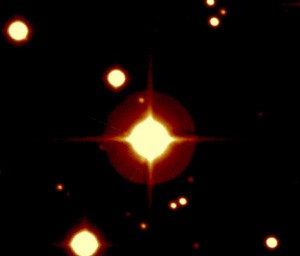about the star of the COROT super-Earth
Discovery of a Super-Earth?
February 4, 2009Visit at Keck Observatory – almost the end
February 7, 2009

mage taken with the CFH telescope (Canada-France-Hawaii) of the star around which orbits CoRoT-Exo-7b. (from Obs. de Paris-Meudon PR)
Dear readers,
Yesterday I wrote a post and an update about the possible discovery of a super-Earth exo-planet by COROT mission. I completely forgot to give you information about the star around which this exoplanet is orbiting.
Until the article is published we will not know the celestial coordinates but D. Rouan told me that it is a young (~1.2 Gyr) and active K0V star, located at 140 parsec from our Sun. A parsec (pc) is a weird unit of length which corresponds 31 trillion of km or 3.26 light-years (lyr). To give you an idea of the distance, the light coming from this star is taking 460 years to reach us which is also 30 million times the distance between the Sun and Earth.
So basically, with the current propulsion system that we use for our spacecraft it will take us centuries to visit this exo-planet. That’s why NASA and ESA space agencies are developing mission concepts like DARWIN or TPF to study these exo-planets from the close environment of our planet.
Greeting from Hawaii,
F.



3 Comments
No coordinates? Not a discovery. Tell ’em to come back when they’re ready to *really* announce. Science is fundamentally built upon open exchange of ideas.
a response to Gerard comment:
I am indeed reluctant to mention a work when it is surrounding by such mystery. This is especially true for exo-planet search programs. However in this case, I made an exception for several reasons: 1. I published the post before noticing that the central star was not made public (I focused on the exo-planet), 2. a paper is about to be submitted so we will have the coordinate in a few days 3. this is a blog not a scientific review, so I can take a few non-scientific decisions 4. I really like the idea of being able to detect smaller and smaller exo-planets, this post is in fact a preliminary discussion before the launch of Kepler.
Dear Franck,
Hello from a fellow blogger (who actually did his Ph.D. thesis on exoplanets, back before it became a true observational science — and whose career then went into a different direction).
I’ve identified the parent star on the Digitized Sky Survey. Approximate coordinates (2000.0) are 6h43m49s.55 -1d03’33”
Sincerely,
Alan